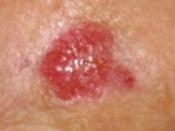'The Dangers of Wanting a Dark Tan.'
Have you ever been to a beach or water park and seen all the teenagers with dark, almost tropical tans? Though the look is appealing, every time you go out into the sun with unprotected skin you are putting yourself at risk of skin cancer. Most people don't think about it, but with today's pollution and deteriorating ozone, skin cancer is becoming ever more prevalent. There are currently 32,000 cases of Melanoma, or skin cancer, in the United States today. The startling fact is that it is growing at a rate of 4.3% a year. It is one of the fastest increases in occurrence rates of all cancers.
The danger in Melanoma is that it starts with something as simple as a mole or growth and can spread to other places on the skin, lymph nodes, lungs, liver, brain, or bones.
Metastatic Melanoma refers to this secondary spread.
There are four common stages to Melanoma. It is determined by how deeply the cancer cells have penetrated the body. They are as follows:
Stage I:
A mole or growth on the top layer of skin.
Stage II:
This indicates that the growth is deeper, but has not spread anywhere else on the body.
Stage III:
This is when the melanoma has spread to a nearby lymph basin or other tissue.
Stage IV:
This is the most serious, where the mutated cells have spread throughout distant parts of the body.
Here are some graphical examples of what typical skin cancer can look like.
Figure 1: Shows a healthy skin lesion. This lesion has no particular risk of developing cancer.
Figure 2: A dysplastic nevi is shown. This is a skin lesion, that has a higher risk of developing cancer and is therefore...


